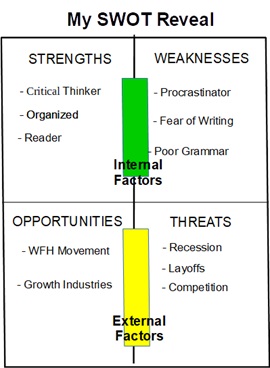SWOT analysis is a popular tool for assessing an organization’s goods and services on an operational or strategic level. The SWOT technique can yield valuable insights for further research, analysis, and decision making. The grid is useful for businesses and industries of all sizes, as well as nonprofits and community-based organizations.

SWOT stands for:
- “S” = internal strengths (Our products have highly desirable features.)
- “W” = internal weaknesses (We have serious supply chain issues.)
- “O” = external opportunities (Customers want services like ours in this environment.)
- “T” = external threats (Knockoffs of our premium product are flooding the market.)
The purpose of SWOT analysis is to identify, match, and maximize an organization’s internal strengths (S) with external market opportunities (O) to help reach its mission and goals. Likewise, an organization needs to identify and address internal weaknesses (W), but perhaps even more important, keep them from harmful external threats (T).
But SWOT analysis can also be a valuable—even critically important—personal tool for assessing written work such as emails, memos, reports, and student term papers. When we apply this insightful technique to our documents, especially in today’s radically changing job landscape, we can uncover strengths to match market opportunities, and weaknesses to alert us to potentially dangerous job threats.
The Online Migration
The COVID-19 pandemic has ejected millions of workers from workplaces and resettled them in home offices. You may no longer benefit from the clarity provided by invaluable face-to-face collaboration. Instead, you might receive the hurried email missive: “Just finish and send it to me asap.” You may also be working with unfamiliar teams instead of enjoying the camaraderie of trusted coworkers.
Many believe the work from home situation is unlikely to end soon, if at all. Derek Thompson, staff writer at The Atlantic, points out that: “In March, tens of millions of American workers—mostly in white-collar industries such as tech, finance, and media—were thrust into a sudden, chaotic experiment in working from home. Four months later, the experiment isn’t close to ending. For many, the test run is looking more like the long run…What’s more, for many workers, their emotional relationships with colleagues have changed because their spatial relationships with those colleagues have changed.”
Strong Written Communication = Job Strength
Your employers may not have hired you as a writer, but they will likely expect you to bring strong written communication skills to the job. A recent Graduate Management Admission Council (GMAC) survey of corporate recruiters stressed that “Strong communication skills have always been and will continue to remain important.”
In another survey, GMAC reported that “Certain skills are essential to your success regardless of job level. For example, the vast majority of b-school alumni at the entry-level (91%), mid-level (94%), senior-level (95%), and executive/c-suite-level (95%) say communications is a skill set essential to being successful.”
The message is clear: Having strong writing skills is a key to job success, and the digital transformation makes strong written communication invaluable. Employers want employees with strong communication skills in the “S” (strengths) quadrant of the organizational employee profile. If employees’ communication skills fall into the “W” (weaknesses) space, the enterprise’s success could be at risk.
But Good Writing Is Hard Work
As adults, we may think that we’ve already absorbed the necessary conventions about written communication. What we learned was adequate for the job. We may have also believed that our written work was not important enough to require skill redevelopment, especially with many other job training requirements. But now, faced with the turmoil of a post-pandemic landscape, we’re locked into home-based written communication that can be intimidating or make us fear that we lack some essential writing skills. And when we don’t have confidence in our writing, we stress over the online delivery of our work or worry that our weaknesses will be exposed.
For many, the fear of writing—and writing well—is real. In his book On Writing Well: The Classic Guide to Writing Nonfiction, writer William Zinsser remarked that “Fear of writing gets planted in most Americans at an early age, usually at school, and it never entirely goes away.” Zinsser also pointed out that “Countless careers rise or fall on the ability or the inability of employees to state a set of facts, summarize a meeting or present an idea coherently.”
On top of our writing concerns, the dangers of COVID-19 have upended our lives. The grim task of concentrating on writing documents becomes even more challenging when mixed with family challenges, job problems, and social unrest. We must also face the reality that some post-pandemic job losses will be permanent—perhaps even our jobs —and that once-thriving industries, the engines of robust hiring, will wither into the past.
If you’re concerned that you didn’t absorb the essential skills of written communication and that your work may reflect more weakness than strength, take the following SWOT test to identify and consider making changes to your writing.
Apply SWOT Analysis to Your Written Work
Adjusting to the new normal workplace may be an opportune time to assess your communication by reviewing a sample of your emails, memos, reports, or school papers. Use the following statements about your work as a starting point for developing your SWOT and add other issues as applicable to your situation:
- I like to write.
- I have graphophobia.
- I excel in critical thinking and project analysis.
- I didn’t learn how to write in school.
- I read a lot.
- I’m overloaded with work and have no time for writing reports.
- Our company encourages us to work from home.
- I have to write my supervisor’s reports for him to submit to his managers.
- My department is being downsized.
- I have bilingual writing skills.
- My supervisor corrects all of my emails to customers.
- I give helpful feedback to my teammates on our writing projects.
- I procrastinate with writing tasks.
- I prefer to communicate digitally because I’m an introvert.
- I’m overwhelmed with past due reports.
- I’m intimidated by what others may think of my written work.
- I’m moving to a new work team next month.
- Friends tell me their company is hiring.
- I never gave much thought to improving my written communication skills.
The SWOT Reveal
Use the responses to your previous questions to create a personal SWOT matrix as the accompanying example shows. Some SWOT items will belong in more than one quadrant. Assess where your work is strong and where you should focus future efforts to develop a more powerful personal branding. Scan for opportunities that could pay off using your existing skills and study weaknesses to avoid the threats of shifting market conditions.

Next, create a plan of action for addressing what’s wobbly about your written work. Here are some ideas to beef up your writing skills and build your digital transformation:
- Hire a coach, tutor, or trainer.
- Take writing courses.
- Read articles and books on how to improve your writing.
- Read for continuous learning.
- Create a buddy system and connect with trusted confidants to give and receive feedback.
- Collaborate in problem-solving specific issues.
- Develop a learning plan based on your SWOT findings.
- If you previously commuted, use the travel time saved to improve your written work.
- Accept that retraining, especially in written communication, is integral to personal success in the modern work landscape.
- Embrace the new way of working online.
- Face any fears about writing.
- Practice, practice, practice writing!
Be SWOT Smart
Employers are becoming aware of the need for better employee workplace skills, and you should be mindful of these changing attitudes. In a New York Times article by Steve Lohr titled “The Pandemic Has Accelerated Demands for a More Skilled Work Force,” the teaser text states that “Even groups that regularly disagree on labor issues said there should be significant public investment in programs that can upgrade the skills of American workers.”
You might suggest that your employer set up an employee retraining plan for developing strong communication skills that explore and solve pressing workplace issues. All signs point to the work from home movement as continuing, so employees who offer increased value through written communication will add value to a company.
Organizations of all sizes and types use SWOT analysis to monitor and improve operations. Employers also place a high value on strong worker communication skills. The importance of this skill set to the organization has been magnified by the work from home movement and the increased online delivery of communication. You, too, can apply SWOT techniques to analyze and develop a personal improvement plan to make your written work a strength that opens new opportunities.
Mary is the author of Teach Me to Write: Four Steps to Great Documents, available on Amazon. Reach her at Teach Me to Write, LLC.
